!date
welcome welcome my web lurkers to
machine learning blurb two¶
this one will actually be more blurby than the last blurb. i promise.
today's blurb is about
SUPERVISED LEARNING¶
sometimes you don't trust the machine when it's learning. so you keep an eye on it.
actually that's not it at all.
supervised learning is when the data that you are using to teach your machine what to do has some of the preferred outcomes. these are called labels.
with labels (oh yeah check out this reinforcement <- foreshadowing), your machine will classify the different labeled data through a process called (wait for it) classification.
example time.
let's say you want to teach your program to classify a bunch of pictures you have of lizards and surf boards.

it was such a coincidence to find this picture after deciding on this example. fate, destiny, and kowabunga dude.
your training set of data would include pictures of both lizards and surfboards and the pictures would carry a label along with them specifying what the picture is of.
the above picture may prove to break your algorithm. algorithm is a fancy scary word programmers use that essentially means a way of doing things. if you have to dip left, roll, dive right, and hop up 3 inches to avoid stubbing your toe on the way to the kitchen every morning, you've come up with an algorithm for not stubbing your toe.
eureka.
moving on.
with enough pictures in your training set of lizards and surfboards, you may be able to give your machine a new instance, or picture in this case of a lizard or a surfboard that doesn't have a label and it should be able to classify this new picture into either group.
all of the above, again, falls under a common supervised learning task called classification.
all of the below would fall under another common supervised learning task called...well nothing special but predicting a specific value or target value. this is done through using a set of features.
example time.
let's say we wanted to predict the price of any given pizza. the features of this pizza would be the price, size, crust type, how many toppings, what kind of toppings, etcetera and so forth. you would feed your machine with many different examples of pizza data including the previous features with labels so your machine knows which features are the actual predictors of the price.
(also key to note here, the word features is sometimes switched out with attributes. much like soda and pop. and soda pop.)
boom. that's all for tonight folks. come back next time when we let the machines learn..
unsupervised.
thanks for playing.